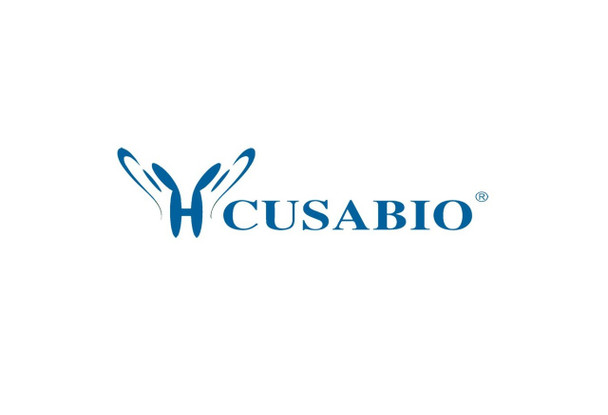Cusabio Active Proteins
Recombinant Human Vascular endothelial growth factor A protein (VEGFA) (Active) | CSB-AP002601HU
- SKU:
- CSB-AP002601HU
- Availability:
- 5 to 10 Working Days
Description
Recombinant Human Vascular endothelial growth factor A protein (VEGFA) (Active) | CSB-AP002601HU | Cusabio
Protein Description: Partial of Isoform VEGF165
Alternative Name (s) : VEGF-A, VPF
Gene Names: VEGFA,VEGF
Research Areas: Cancer
Species: Homo sapiens (Human)
Source: E.Coli
Tag Info: Tag-Free
Expression Region: 27-191aa
Sequence Info: M+APMAEGGGQ NHHEVVKFMD VYQRSYCHPI ETLVDIFQEY PDEIEYIFKP SCVPLMRCGG CCNDEGLECV PTEESNITMQ IMRIKPHQGQ HIGEMSFLQH NKCECRPKKD RARQENPCGP CSERRKHLFV QDPQTCKCSC KNTDSRCKAR QLELNERTCR CDKPRR
Biological Activity: Fully biologically active when compared to standard. The ED50 as determined by a cell proliferation assay using human umbilical vein endothelial cells (HUVEC) is between 1.0-8.0 ng/ml.
MW: 19.3 kDa
Purity: >95% as determined by SDS-PAGE and HPLC.
Endotoxin: Less than 1.0 EU/µg as determined by LAL method.
Relevance: Growth factor active in angiogenesis, vasculogenesis and endothelial cell growth. Induces endothelial cell proliferation, promotes cell migration, inhibits apoptosis and induces permeabilization of blood vessels. Binds to the FLT1/VEGFR1 and KDR/VEGFR2 receptors, heparan sulfate and heparin. NRP1/Neuropilin-1 binds isoforms VEGF-165 and VEGF-145. Isoform VEGF165B binds to KDR but does not activate downstream signaling pathways, does not activate angiogenesis and inhibits tumor growth. {ECO:0000269|PubMed:11427521, ECO:0000269|PubMed:16489009}.
PubMed ID: 2479986; 2479987; 1711045; 1791831; 1567395; 9054410; 9878851; 9450968; 10464055; 12124351; 19054851; 14574404; 15489334; 7678805; 15340161; 2584205; 10067980; 11563986; 11427521; 11731620; 11978667; 15520188; 14764596; 15896327; 16489009; 22009797; 9207067; 9336848; 9351807; 9922142; 9634701
Notes: Repeated freezing and thawing is not recommended. Store working aliquots at 4℃ for up to one week.
Function: Growth factor active in angiogenesis, vasculogenesis and endothelial cell growth. Induces endothelial cell proliferation, promotes cell migration, inhibits apoptosis and induces permeabilization of blood vessels. Binds to the FLT1/VEGFR1 and KDR/VEGFR2 receptors, heparan sulfate and heparin. NRP1/Neuropilin-1 binds isoforms VEGF-165 and VEGF-145. Isoform VEGF165B binds to KDR but does not activate downstream signaling pathways, does not activate angiogenesis and inhibits tumor growth. Binding to NRP1 receptor initiates a signaling pathway needed for motor neuron axon guidance and cell body migration, including for the caudal migration of facial motor neurons from rhombomere 4 to rhombomere 6 during embryonic development (By similarity) .
Involvement in disease: Microvascular complications of diabetes 1 (MVCD1)
Subcellular Location: Secreted
Protein Families: PDGF/VEGF growth factor family
Tissue Specificity: Isoform VEGF189, isoform VEGF165 and isoform VEGF121 are widely expressed. Isoform VEGF206 and isoform VEGF145 are not widely expressed. A higher level expression seen in pituitary tumors as compared to the pituitary gland.
Paythway: HIF-1signalingpathway
Form: Lyophilized powder
Buffer: Lyophilized from a 0.2 µm filtered PBS, pH 7.4
Reconstitution: We recommend that this vial be briefly centrifuged prior to opening to bring the contents to the bottom. Please reconstitute protein in deionized sterile water to a concentration of 0.1-1.0 mg/mL.We recommend to add 5-50% of glycerol (final concentration) and aliquot for long-term storage at -20℃/-80℃. Our default final concentration of glycerol is 50%. Customers could use it as reference.
Uniprot ID: P15692
Uniprot Entry Name: VEGFA_HUMAN
HGNC Database Link: HGNC
UniGene Database Link: UniGene
KEGG Database Link: KEGG
STRING Database Link: STRING
OMIM Database Link: OMIM









